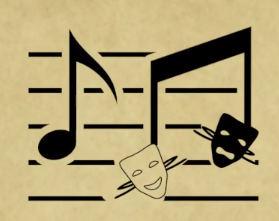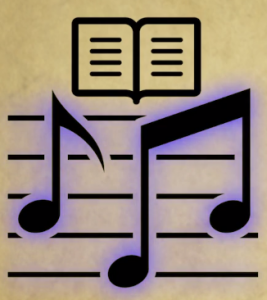Listener’s Toolbox
Definitions are adapted from The New Grove Dictionary of Opera and Oxford Music Online. We have included references to where the term or idea was first introduced for review.
- How we Listen infographic
- Glossary
- Accessing the operas
How we listen infographic
Below you will find out How we Listen instruction graphic. To download a more accessible PDF version, click here to download the PDF.
Glossary
adagio: from Italian, “at ease,” “leisurely”; in the nineteenth century, generally agreed to be the slowest tempo. WK3
aria: often paired with “recitative,” an aria (Eng. “air”) is akin to a song, with its music more regular in rhythm and its words usually reflective in nature (e.g., pensive or angry or heroic or sad, etc.). WK3
bel canto: Rossini is alleged to say (1858) that bel canto singing “involved three requirements: 1) a naturally beautiful voice, even in tone throughout its range; 2) careful training that encouraged effortless delivery of highly florid music; and 3) a mastery of style that could not be taught but only assimilated from listening to the best Italian exponents.” WK3
cabaletta: “the second, usually fast movement of a double aria in an Italian opera, consisting of a melodic period of two stanzas which is repeated with decorations added by the singer … Only rarely does a cabaletta occur in isolation, without a preceding cantabile. …” WK3
cadenza: an unaccompanied passage inserted near the end of a concerto movement or aria. A cadenza is often virtuosic, especially in faster compositions. WK3
cantabile: “the first, slow movement of a double aria”; often called a cavatina by twentieth-century writers, though not by nineteenth-century practitioners. WK3
castrato: a male singer whose soprano or contralto voice is preserved by undergoing castration before reaching puberty. Castrati were in great demand in Italian opera in the seventeenth and eighteenth centuries, and castrati continued to appear in operas and the Sistine Chapel into the nineteenth century. WK2
![]() chain finale: an operatic ensemble finale, developed during the eighteenth century and continuing into to nineteenth and often found in an opera buffa, in which a number of distinct sections, usually differentiated in key, meter, and tempo, succeed each other in response to a developing dramatic situation. WK1; WK3
chain finale: an operatic ensemble finale, developed during the eighteenth century and continuing into to nineteenth and often found in an opera buffa, in which a number of distinct sections, usually differentiated in key, meter, and tempo, succeed each other in response to a developing dramatic situation. WK1; WK3
chorus: a group of singers who perform together either in unison or, much more usually, in parts; also, by extension, a work, or movement in a work, written for performance by such an ensemble (e.g. the “Hallelujah” chorus in Handel’s Messiah). WK3
![]() da capo aria: literally, “from the head.” An extended and well‐developed solo vocal piece in A‐B‐A form. WK2
da capo aria: literally, “from the head.” An extended and well‐developed solo vocal piece in A‐B‐A form. WK2
dramma per musica: literally, “drama through music.” A term used in the seventeenth and eighteenth centuries for opera seria. WK2
favola in musica: a term from the seventeenth century to describe opera libretti that are mythological or legendary in character. WK2
largo: same tempo as adagio, but with the connotation of grandeur. WK3
lieto fine: literally, “happy ending.” A term used to denote the happy conclusion of a drama or operatic libretto, a basic ingredient of the genre of opera, particularly during the first two centuries of its development. WK2
libretto: literally, “little book.” The words of an opera that the composer sets to music. WK1
mad scene: an operatic scene in which a character, usually the soprano heroine, exhibits mental collapse; amnesia, hallucination, irrational behavior, and sleepwalking are common in such moments. Here is a PDF of mad scenes from Monteverdi to Corigliano.
 opera: a dramatic work meant for the stage where the actresses and actors sing most or all of the drama and possess voices of uncommon skill, usually acquired through extensive training. WK1
opera: a dramatic work meant for the stage where the actresses and actors sing most or all of the drama and possess voices of uncommon skill, usually acquired through extensive training. WK1
opera seria: literally, “serious opera.” The primary operatic genre in the seventeenth and eighteenth centuries. Mythological and historical subjects were common. The last and greatest examples of the genre are Mozart’s Idomeneo (1781) and La clemenza di Tito (1791). WK2
opera buffa: literally, “comic opera.” A genre of opera that emerged in the early eighteenth century. Characters drawn from everyday life were common. Examples include Mozart’s Le nozze di Figaro (1786), Rossini’s Il barbiere di Siviglia (1816), and Donizetti’s Don Pasquale (1843). WK2
overture: a piece of instrumental music that precedes the start of the dramatic action in an opera, oratorio, play or (sometimes) ballet. In the nineteenth century, some composers preferred the term prelude for this music. WK3
pezzo concertato: “a large ensemble of soloists and chorus generally to be found as the second movement of a central finale, to which it forms the lyrical climax.” WK3
recitative: often paired with “aria,” recitative (think: recitation) refers to declamatory speech‐like singing that: 1) is usually free in rhythm, and 2) sets dialogue or narrative that advances the story. WK3
 score: a written representation of a musical composition that shows all the vocal and instrumental parts in vertical alignment. In the case of opera, a piano-vocal score presents a piano reduction of the instrumental parts while preserving the vocal parts. WK1
score: a written representation of a musical composition that shows all the vocal and instrumental parts in vertical alignment. In the case of opera, a piano-vocal score presents a piano reduction of the instrumental parts while preserving the vocal parts. WK1
stile rappresentativo: literally, “representational style.” Early Italian composers of opera and oratorio used the term to describe their manner of setting normal human speech in musical works. WK2
stretta: “the rapid, concluding movement of an ensemble.” WK3
tempo d’attacco: “the first, fast movement of a closed number following the recitative or scena … It is most commonly applied to duets, whether in two movements or the more usual three.” WK3
tempo di mezzo: “a fast transitional passage that separates a cantabile from a cabaletta or a pezzo concertato from a stretta. It is generally free in form and varies in length according to the dramatic situation, its prime function being to effect the required change of mood.” WK3


